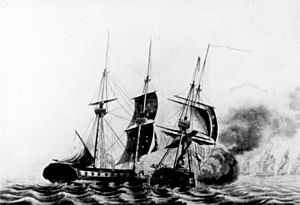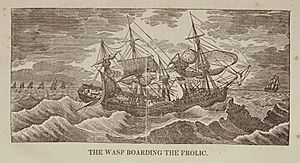Capture of HMS Frolic facts for kids
Quick facts for kids USS Wasp vs HMS Frolic |
|||||||
|---|---|---|---|---|---|---|---|
| Part of the War of 1812 | |||||||
 USS Wasp captures HMS Frolic - Drawing and engraving by F. Kearny, based on sketch by Lieutenant Claxton |
|||||||
|
|||||||
| Belligerents | |||||||
| Commanders and leaders | |||||||
| Strength | |||||||
| 1 sloop-of-war (18 guns) 135 Marines and Sailors |
1 brig-sloop (18 guns) 110 Marines and Sailors |
||||||
| Casualties and losses | |||||||
| 3 killed 8 wounded |
30 killed 60+ wounded |
||||||
The capture of HMS Frolic was an exciting sea battle during the War of 1812. It happened on October 18, 1812, in the Atlantic Ocean. The American warship USS Wasp, led by Captain Jacob Jones, fought against the British ship HM Brig Frolic, led by Commander Thomas Whinyates. The Americans won this fight and captured the British ship. However, soon after, a much larger British warship appeared and captured both the Wasp and the Frolic.
| Top - 0-9 A B C D E F G H I J K L M N O P Q R S T U V W X Y Z |
Getting Ready for Battle
British Ship Frolic Prepares
On September 12, 1812, a group of fourteen British merchant ships left the Gulf of Honduras. They were sailing towards Britain. The British warship Frolic was protecting them.
On October 16, a big storm hit the ships. This happened about 300 miles (480 km) north of Bermuda. The storm scattered the convoy, meaning the ships were spread out. The Frolic's main mast was broken.
During October 17, the crew of the Frolic worked hard to fix their ship. By nightfall, six of the merchant ships had rejoined them.
American Ship Wasp Sets Sail
The American warship USS Wasp had left the Delaware River on October 13. It was sailing southeast to find ships traveling between Britain and the Caribbean. The Wasp also got a little damaged in the same storm on October 16. It lost part of its front mast.
At 11:30 pm on October 17, the Wasp's crew saw several ships in the distance. Captain Jacob Jones, who commanded the Wasp, kept his ship far away during the night. At dawn, he saw they were merchant ships. He also saw a British warship between them and the Wasp. The British ship had raised Spanish flags to try and trick the Wasp into coming closer.
The Sea Battle Begins
Even though the storm had passed, the wind was still strong. The sea was also very rough. Both ships got ready for a fight. They shortened their sails to make them easier to handle. The Frolic's crew took down their broken mast and tied it to the deck.
Both ships used short-range cannons called carronades. This meant they had to get very close to each other to fight. They did not try to move around to get a better position. Instead, they just sailed towards each other.
Close-Range Cannon Fire
At 11:30 am, the ships were very close, about 60 yards apart. They both started firing their cannons. The Wasp was slightly to the right and upwind. The Frolic was to the left.
The Wasps crew aimed their cannons low. They wanted to hit the Frolics hull, which is the main body of the ship. The Frolics gunners aimed high. This was unusual for the British Navy. They wanted to damage the Wasps sails and ropes.
As the battle continued, the ships got even closer. They were so close that the American gunners could hit the sides of the Frolic with their ramrods as they reloaded their cannons.
The Frolic is Overpowered
After 22 minutes of intense fighting, the Wasp's ropes and masts were badly damaged. Its main topmast and other parts were shot away. Almost all its ropes were cut. This made the Wasp hard to control.
The Frolic was even more damaged. Many of its crew members were hurt or killed. Both ships were now very difficult to steer. The Wasp moved slightly ahead, and the Frolic crashed into the American ship.
The Wasp fired one last powerful shot into the Frolic's side. This was the final blow. At 11:52 am, American sailors boarded the Frolic. They found that every British officer was wounded or dead. More than half of the crew, 90 men, were also wounded or dead. The Americans had only 10 casualties. Everyone agreed that the British crew fought very bravely. However, the American gunners were much better at hitting their targets.
What Happened Next
Both Ships Captured
Soon after the battle ended, the Frolic's masts fell down. An American crew went onto the Frolic to try and fix its ropes. But a few hours later, a very large British warship appeared. It was a 74-gun ship of the line called HMS Poictiers, commanded by Captain John Beresford.
The Frolic was still badly damaged and could not be controlled. The Wasp also had damaged ropes and could not escape. Facing such a powerful enemy, the Wasp had to surrender. Captain Beresford was supposed to join other British ships blocking the American coast. But he decided to take the Frolic's merchant convoy to Bermuda. They had to stay there for several days until another escort ship could be found.
Captain Jones's Future
Captain Jacob Jones and his crew were soon set free. This happened through an exchange of prisoners. Jones was promoted to a higher rank. He was then given command of USS Macedonian. This ship had been captured from the British Navy just a week after the Frolic battle. Later, Captain Jones became the second-in-command to Commodore Isaac Chauncey on Lake Ontario.
The Ships' Fates
The Frolic was too badly damaged to ever fight again. It was taken apart in November 1813. The Wasp was taken by the British Navy. They renamed it HMS Loup Cervier. In 1814, it was renamed HMS Peacock. However, the ship disappeared off the coast of Virginia in 1814 and is thought to have been wrecked.


